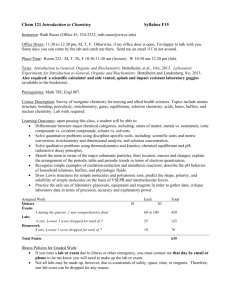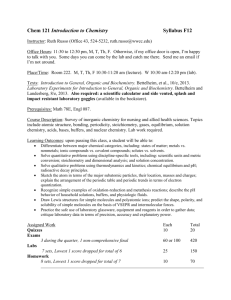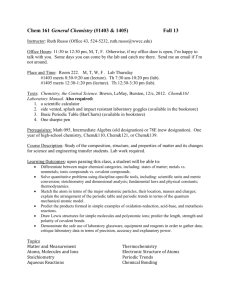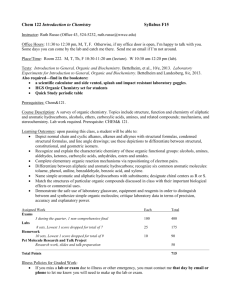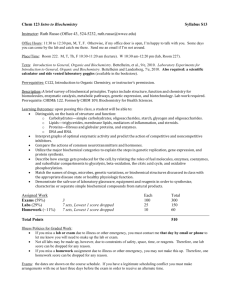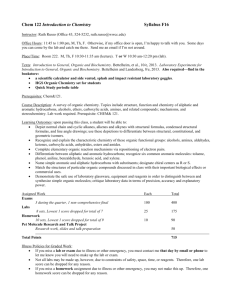View Syllabus
advertisement
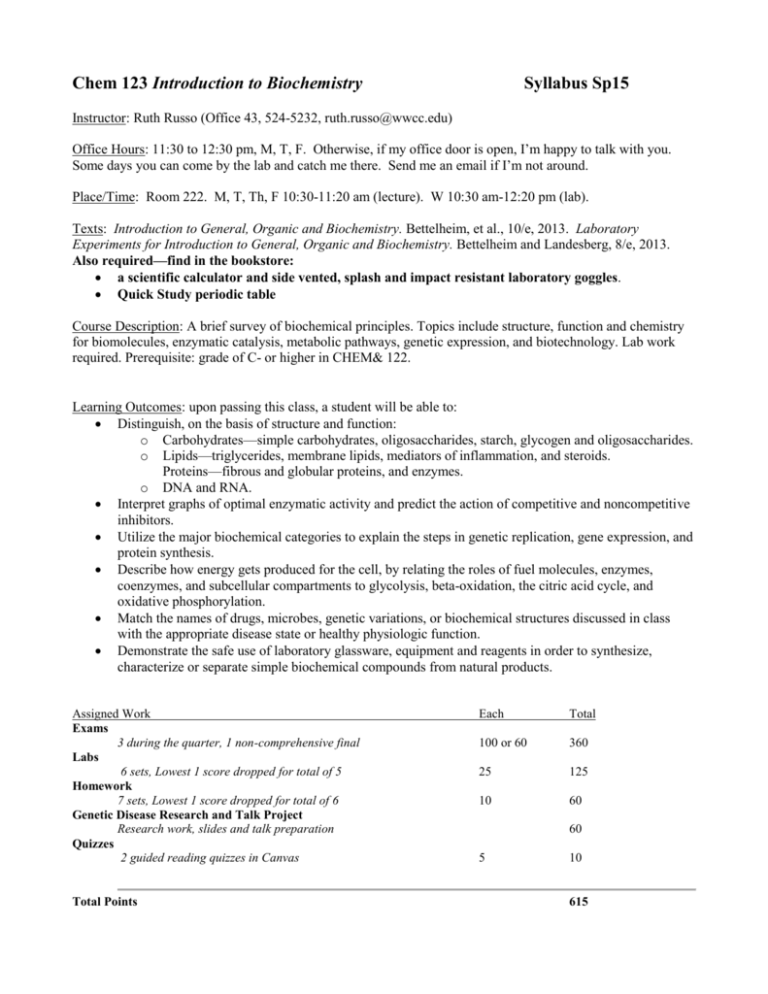
Chem 123 Introduction to Biochemistry Syllabus Sp15 Instructor: Ruth Russo (Office 43, 524-5232, ruth.russo@wwcc.edu) Office Hours: 11:30 to 12:30 pm, M, T, F. Otherwise, if my office door is open, I’m happy to talk with you. Some days you can come by the lab and catch me there. Send me an email if I’m not around. Place/Time: Room 222. M, T, Th, F 10:30-11:20 am (lecture). W 10:30 am-12:20 pm (lab). Texts: Introduction to General, Organic and Biochemistry. Bettelheim, et al., 10/e, 2013. Laboratory Experiments for Introduction to General, Organic and Biochemistry. Bettelheim and Landesberg, 8/e, 2013. Also required—find in the bookstore: a scientific calculator and side vented, splash and impact resistant laboratory goggles. Quick Study periodic table Course Description: A brief survey of biochemical principles. Topics include structure, function and chemistry for biomolecules, enzymatic catalysis, metabolic pathways, genetic expression, and biotechnology. Lab work required. Prerequisite: grade of C- or higher in CHEM& 122. Learning Outcomes: upon passing this class, a student will be able to: Distinguish, on the basis of structure and function: o Carbohydrates—simple carbohydrates, oligosaccharides, starch, glycogen and oligosaccharides. o Lipids—triglycerides, membrane lipids, mediators of inflammation, and steroids. Proteins—fibrous and globular proteins, and enzymes. o DNA and RNA. Interpret graphs of optimal enzymatic activity and predict the action of competitive and noncompetitive inhibitors. Utilize the major biochemical categories to explain the steps in genetic replication, gene expression, and protein synthesis. Describe how energy gets produced for the cell, by relating the roles of fuel molecules, enzymes, coenzymes, and subcellular compartments to glycolysis, beta-oxidation, the citric acid cycle, and oxidative phosphorylation. Match the names of drugs, microbes, genetic variations, or biochemical structures discussed in class with the appropriate disease state or healthy physiologic function. Demonstrate the safe use of laboratory glassware, equipment and reagents in order to synthesize, characterize or separate simple biochemical compounds from natural products. Assigned Work Exams 3 during the quarter, 1 non-comprehensive final Labs 6 sets, Lowest 1 score dropped for total of 5 Homework 7 sets, Lowest 1 score dropped for total of 6 Genetic Disease Research and Talk Project Research work, slides and talk preparation Quizzes 2 guided reading quizzes in Canvas Total Points Each Total 100 or 60 360 25 125 10 60 60 5 10 615 Illness Policies for Graded Work: If you miss a lab or exam due to illness or other emergency, you must contact me that day by email or phone to let me know you will need to make up the lab or exam. Not all labs may be made up, however, due to constraints of safety, space, time, or reagents. Therefore, one lab score can be dropped for any reason. If you miss a homework assignment due to illness or other emergency, you may not make this up. Therefore, one homework score can be dropped for any reason. Exams: the dates are shown on the course schedule. If you have a legitimate scheduling conflict you must make arrangements with me at least three days before the exam in order to receive an alternate time. Labs: 1. The due dates for Prelabs, Results, Questions and Post-labs are on the schedule. 2. Wear closed-toe shoes and long pants to every lab. Bring your laboratory goggles. If you forget, I may not allow you to work that day, depending upon the nature of the experiment, and you will receive a zero for that lab. 3. Labs either come from Handouts, or from the hard-copy Lab Manual. 4. When assigned, Prelabs are always due at the beginning of lab. I want you to make a good-faith effort at answering all the questions before you walk into lab, most importantly so that you know what you don’t know! I will check that you completed the Prelab before you begin working. 5. The Experiments, consisting of Prelabs, Results, Questions and Postlabs, are due either as you leave lab or on the next day, as listed in the syllabus. 6. Labs are each worth 25 points. The points are earned as follows: a. Prelab done prior to lab (5 points) b. Content of Prelabs, Results, Questions and Postlabs (20 points) Graded Homework: the homework assignments (10 points each) are due as listed on the schedule. They consist of two parts: ungraded practice problems and graded problems. 1. Ungraded Practice Problems (5 points). I want to see evidence that you have attempted the oddnumbered problems that I suggest from the end-of-chapter problems. Most of these have answers in the back of the book, but I want to see your sketches, attempts, calculations, etc. These can be “sloppy copies.” Staple these to the Graded Problems. 2. Graded Problems (5 points): these will be even-numbered end-of-chapter problems (or problems that I make up) that don’t have answers in the back of the book. These are problems that show me whether or not you understand concepts, calculations, and information prior to the exams. 3. Homework assignments will be posted on the Canvas shell for each chapter, found under the appropriate Chapter module. Accommodations: To request accommodations related to a disability, contact Claudia Angus, Ph.D., Coordinator of Disability Support Services, at 527-4262 or email claudia.angus@wwcc.edu. Accommodations can include note takers, extra time on exams, etc. Etiquette: Please be courteous to your fellow students and me. 1) Please do not answer your cell phone or text during class. If you absolutely need to be in contact for family or work reasons, set the phone to vibrate and take the call outside the door. 2) Please do not be consistently late for class. If you have transportation issues, let me know. 3) Please do your best for your lab partner and everyone else in the lab. You are mutually responsible for the success of the lab pair, and the safety of everyone relies upon you! Grading Scale: the grading scale below depicts the highest “floors” for each category that I predict. For example, if you have a 93% on all work, you would receive an A, while someone with 92% on all work would receive an A-. I reserve the right to lower the floors at the end of the quarter based upon both student and instructor performance relative to years past. In this case, the 92% might merit an A if I have designed especially difficult exams, e.g. Percent 93-100 90-92.9 87-89.9 83-86.9 80-82.9 77-79.9 73-76.9 70-72.9 67-69.9 63-66.9 0-62.9 Letter Grade A AB+ B BC+ C CD+ D F 4 point scale 4.0 3.7 3.3 3 2.7 2.3 2 1.7 1.3 1 0 After week 2, your grades will be available to you in real time on the Canvas shell. Prior to the end of week 2, there are not enough data in the gradebook for the percentage to make sense. Withdrawal Policy You may withdraw from the course without a grade through May 15, 2015. After this date, you will receive a grade whether or not you continue to attend class. Extra Help The most successful chemistry students are the ones who plug away with a determined work ethic. Asking for help early and often is a wise and strategic move. Come see me often. I love students who ask a lot of questions. Dr. Laura Schueller in the Tutoring Center is also an excellent resource (in addition to being brilliant, she brings treats to the tutoring center on Fridays). The Tutoring Center hires a chemistry-specialist tutor early in the quarter, so introduce yourself and visit him or her often. You can also direct questions to Keenan Failing in the Stockroom, especially if it deals with aqueous chemistry. We are all here to help you succeed. Academic Honesty: cheating and/or plagiarism will incur a penalty ranging from F on the assignment, to failing the course or being expelled from the college. See www.wwcc.edu Current StudentsStudent ResourcesStudent PoliciesStudent Code of Conduct. Schedule: we shall be following the attached calendar. It may be modified due to circumstances beyond my control. My suggestion is to carry it in your backback or notebook and refer to it weekly, to plan your studying, and daily, to see what is due tomorrow. The Canvas environment for our class: we have an online “shell” in the Canvas system. This serves three major functions: 1. I post all my handouts, power points, and homework assignments) in Canvas. Some students like to print out the power points for each chapter to take notes upon. ALL students ought to look at the study guides before exams. 2. You can look at your grades as soon as I enter in your points for each assignment. It is pretty meaningless until Week 3 but then it is quite useful. 3. If I need to make corrections, additions, announcements, etc., I will send these out via Canvas. Most importantly, if I get SICK and can’t come in, I will try to give you some advanced warning from home via Canvas. 4. Please set your Notifications tab in Canvas to whatever mode you check most frequently. MONDAY LECTURE TUESDAY LECTURE Week 1: 3/304/3 Week 3: 4/13-17 Ch. 20 Carbs. Due: choice of disease. Sign up on my door. Dr. Russo is at a conference for this week. Ch. 21 Lipids. Guided Reading on Prostaglandins, Thromboxanes and Leukotrienes. See Module in Canvas for activity. Ch. 21 Quiz due 11 pm. Ch. 21 Lipids. Homework Ch. 20 due 3 pm. Ch. 21 SelfGuided Homework/Test Prep Day. Classroom will be open for your use. Homework Ch. 21 due 3 pm on my door.The key will be posted in Canvas, 4pm for you to check. Week 4: 4/20-24 Ch. 22: Proteins Ch. 22: Proteins Week 2: 4/6-10 THURSDAY LECTURE FRIDAY LECTURE Ch. 20 Carbohydrates. Intro to Genetic Diseases Project.NO LAB Ch. 20 Carbohydrates Ch. 20 Carbohydrates Expt. 32: Carbs. Due: Prelab Ch. 23: Enzymes Exam I: Ch. 20 and 21. Report to the Testing Center with Picture ID at 10:30 am. Expt. 35: Hand Cream. Due: Prelab Expt. 38: Amino Acid Chromatography. Due: Prelab Homework Day. Due: Ch. 23 HW 3 pm. Expt. 40: Casein. Due: Prelab Advising Dayreport to lab. Expt. 47: Vitamin C. Due: Prelab. Week 6: 5/4-8 Homework Day. Due: Ch. 22 HW 3 pm. Ch. 23: Enzyme. Due: Prelim Bibliography Genetic Diseases Project. Week 7 5/11-15 Ch. 24: Neurotransmitters and Hormones Ch. 24: Neurotransmitters and Hormones Week 8: 5/18-22 Ch. 25/26: Nucleotides and Gene Expression Ch. 25/26: Nucleotides and Gene Expression Week 9: 5/25-29 Memorial Day Review: Ch. 24 and 25/26. Week10: 6/1-5 Ch. 27: Bioenergetics Ch. 27: Bioenergetics Week 11: 6/812 Genetic Disease Talk I Genetic Disease Talk II Week 5: 4/275/1 WEDS LAB Expt. 43: Onion DNA. Due: prelab Exam III: meet in classroom Ch. 24 and 25/26. Meet in class-check out lab. HW Ch. 27 Due 3 pm. Ch. 21 Lipids. Due: Carbs lab. Jana Lu Williams and Jen Stutesman: Genetic Disease Research in Resource Room (library). Attendance is mandatory. Due: Q 1-3 on "From Topic to Info" worksheet. Ch. 21 Lipids Ch. 22: Proteins. Guided Reading on Proteins Introduction and Amino Acids. See Module in Canvas for activity. Ch. 22 Quiz due 11 pm. Ch. 22: Proteins. Due: Expt 35. Ch. 22: Proteins Ch. 23: Enzymes. Due: Expt 38. Ch. 23: Enzymes Review: Ch. 22 and 23. Due: Expt. 40. Ch. 24: Neurotransmitters and Hormones. Due: Expt. 47. Ch. 25/26: Nucleotides and Gene Expression. Due: Expt. 43. Ch. 27: Bioenergetics Review: Ch. 27. Exam II: Ch. 22 and 23 Ch. 25/26: Nucleotides and Gene Expression Due: Ch. 24 HW 3 pm. Homework Day. Due: Ch. 25/26 HW 3 pm Ch. 27: Bioenergetics Exam IV (half exam): Ch. 27. Genetic Disease Quiz (Canvas) Due by 12:30 pm.
